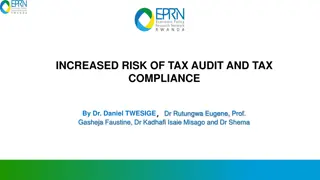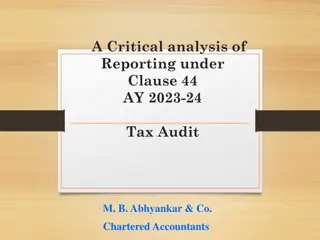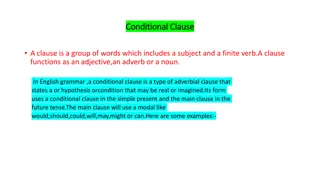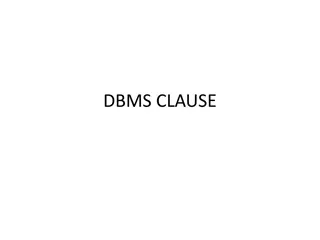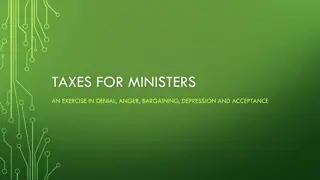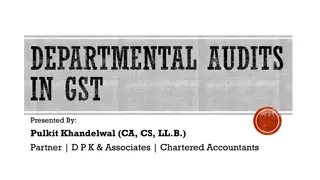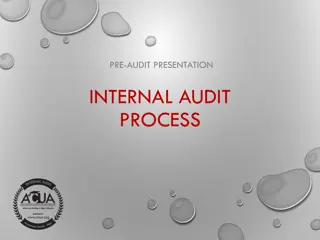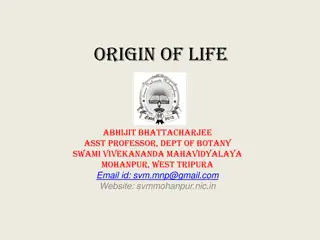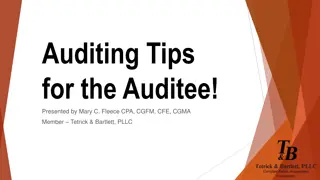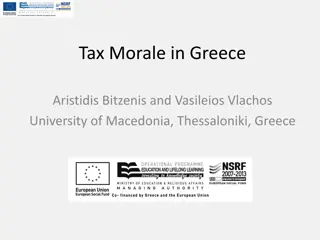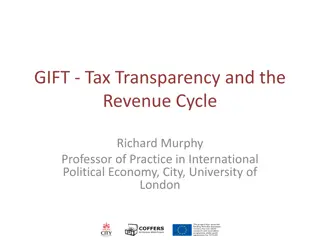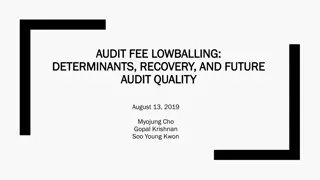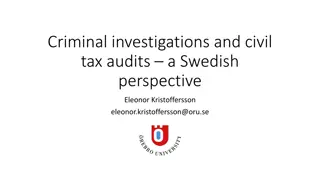Understanding Clause 44 of Tax Audit Report with CA Abhijit Kelkar
In the Tax Audit Report under the Income Tax Act, Clause 44 has become mandatory from April 2022 onwards. This clause requires detailed reporting of various expenditure and payment details related to GST-registered entities. The provision was kept on hold till March 2022 due to the pandemic, but now it must be complied with for the FY 2021-22 tax audits. Both auditees and auditors need to ensure accurate reporting to avoid any discrepancies. Stay informed about the implications of Clause 44 with insights from CA Abhijit Kelkar.
Download Presentation

Please find below an Image/Link to download the presentation.
The content on the website is provided AS IS for your information and personal use only. It may not be sold, licensed, or shared on other websites without obtaining consent from the author. Download presentation by click this link. If you encounter any issues during the download, it is possible that the publisher has removed the file from their server.
E N D
Presentation Transcript
Clause No. 44 of the Tax Audit Report Confusion & Clarification BY CA. ABHIJIT KELKAR WWW.ABHIJITKELKAR.COM
Background of Tax Audit Report Under the Income Tax Act, 1961, every person carrying on business is required to get his accounts audited, if his total sales, turnover or gross receipts, in business exceed Rs. 1 crore in any previous year. The limit has been increased to Rs. 5 crores for business under section 44AB where at least 95 per cent turnover is made on digital transactions. Which was further increased to Rs. 10 crore vide Finance Act, 2021. In the case of a person carrying on the profession, he is required to get his accounts audited, if his gross receipt in profession exceeds, Rs. 50 lakh in the previous year. The purpose of a tax audit is to validate the income tax computation made by the taxpayer in the income tax return and to ensure compliance with the laws of Income Tax. Form 3CD of Tax Audit Report (TAR) was amended in July 2018 by Notification No. 33/2018 dated 20.07.2018 inter alia to incorporate the following two clauses - Clause 30C on reporting of GAAR transactions and Clause 44 on reporting of GST transactions.
Clause 44 of Tax Audit Report The applicability of clause 44 of tax audit report was kept in abeyance till 31stMarch 2022 due to the prevailing Covid-19 situation in the country. However, for tax audit reports filed from 1stApril 2022 onwards, reporting under this clause will be mandatory. Hence, you will be required to report the information as required in this clause for tax audit for the FY 2021-22. The primary duty of submission of the details is of Auditee and for verification of the information supplied under this clause can be verified form the GSTR-2A, GSTR-2B, AIS and other records available with the dealer. Most of the information required for this clause is already available with the Law makers in the form of GSTR-2A and AIS and what is the use of this information in Form 3CD is better known to the lawmakers but since the clause is there hence the Assesssee and Auditor has to follow and comply it.
One may carefully note that this new clause is applicable to all the assessees whether the assessee is registered under GST or not. Further, the clause is applicable even for assessees who are required to get the books of accounts audited under presumptive scheme of taxation. Further, reporting under this clause is required for all the expenditure- revenue expenditure as well as capital expenditure. Even the purchase details will also form part of these reporting requirements.
Clause No. 44 1. SR.No. 2. Total amount of Expenditure incurred during the year 3. Expenditure in respect of entities registered under GST a. Relating to goods or services exempt from GST b. Relating to entities falling under composition scheme c. Relating to other registered entities d. Total payment to registered entities (total of a+b+c) 4. Expenditure relating to entities not registered under GST
Column 1- Sr. No. Analysis of column (1) of the table, which requires mention of the serial number, suggests that expenditures are required to be reported in a head-wise manner. Otherwise, if it is interpreted to be a consolidated figure then there is no requirement to mention the serial number in the table. One can give consolidate figures for all the expenditure under this clause or one can give Revenue and Capital Expenditure under the serial Number 1 and 2 The Form 3CD utility provides for adding rows more than one. However, the possibility of a contrary alternative view cannot be ruled out.
Column 2 . The total amount of expenditure incurred during the year Here, the total expenditure incurred during the year shall be considered. It should incorporate total expenses incurred by the assessee during the relevant financial year including capital expenditure. This should include all sorts of expenses including purchases. Apart from the expenses in Statement of Profit and Loss, the capital expenditure incurred like purchase of fixed assets is also required to be included for reporting the same in the tax audit report. The expenses which are incurred not yet paid will also have to be disclosed ? Even though there is an option to make entries serial wise, there does no exist any column to mention the nature of expenses or the name thereof, like purchases, Commission, electricity expenses or capital expenses. So in my opinion we should consolidate all the expenses and make a single entry or can enter like Purchases, Revenue Expenses, Capital Expenses etc(?)
What about Depreciation? Whether depreciation will be included in total expenditure ? Under clause 44, details of expenditure are being asked for with break up between the inward supplies received from registered and unregistered suppliers. As depreciation as an expense is not towards any inward supply, the same will not be included in the total expenditure. Further in case of Depreciation, In my opinion there is no need to include figure of depreciation in these figures because in that case further bifurcation is not possible but if you choose to include the figure of depreciation then use your discretion and ask the client to submit the details in such manner.
Column 2.. Whether expenditure on non-supplies are required to be reported? The main issue is that whether the expenditure which is not directly incurred towards supply of any goods or service like payment of salary to employee, would be required to be disclosed or not. There are two approaches. Conservative Approach: An expenditure should be disclosed as the heading does not say that 'expenditure on supply' is to be reported only. Rather it states that expenditure is to be disclosed. Another Approach: The main objective of the Central Government is to introduce this clause for matching such figures with the GST returns, wherein non-supplies are not required to be disclosed and, thus, there should be no need to disclose expenditure incurred on non-supplies. The Appropriate Authority needs to issue clarification in this regard.
Column 2 Whether GST amount will be included in total expenditure? This is also a tricky issue !!! However, as the term used is total expenditure incurred, it should include the GST amount in respect of inward supply of goods or services or both. A clue which corroborates the above view is in shape of column 6 of table to clause 44 which provides for disclosure of total payment to registered entities, which naturally includes GST.
Expenditure in respect of entities registered under GST (This section has been further divided into 4 parts) Part a. Relating to goods or services exempt from GST (Column 3) It includes those expenses that have been exempted from GST. As per Section 2(47) of the CGST Act, exempt supply includes the following supplies of goods or services or both: That attracts NIL rate of tax or That is wholly exempted from tax under section 11 of the CGST Act or wholly exempted from tax under section 6 of IGST Act or Non-taxable supply Even if certain expenses are exempt from GST still the same has to be reported under column 3 if such transactions have been entered into with a GST registered person example interest paid to a GST registered person. Zero-rated supplies from registered dealers will also be included It may be noted here that activities / transactions which are not regarded as supplies as per Schedule III of the CGST Act are not required to be disclosed here. (Column 5 or 7)
Expenditure in respect of entities registered under GST Part b. Relating to entities falling under the composition scheme (Column 4) It includes the amount of expenditure incurred from the composition dealers. To know whether any of the vendors was a composition dealer or not, you can either recheck the vendor invoice or visit the GST portal and search the vendor through GSTIN to know his registration status. It may be noted here that details of value of inward supplies under composition scheme, exempt and NIL rated supply are also required to be disclosed in return form GSTR 3B and while disclosing data here it should be ensured as an Auditor that the total of column 3 (exempt supply) and 4 (composition scheme) matches with the figures as disclosed in GSTR 3B filed by the auditee.
Part c. Relating to other registered entities (Column 5) It includes those expenditures that are neither exempted from GST nor incurred from the composition dealer. In other words, it includes the normal supplies received from the registered persons. Under this heading the amount of expenditure incurred on inward supplies of goods or services or both will be mentioned. The amount of expenditure to be disclosed here would be inclusive of GST. Further, here also it should be ensured as an Auditor that the amount disclosed tallies with the figures as disclosed in GSTR 3B filed by the auditee. However, while matching appropriate adjustment be made for GST as in GST returns the value would be depicted without GST.
Part d. Total payment to registered entities (Column 6) This is the sum total of all the expenditures you incurred in the above column (3), (4) and (5). Total payment to registered entities. Based upon the prima facie examination of the format in which details of expenditure are to be given, it appears that the total of the amounts stated in the columns 3, 4 and 5 would be stated here. However, this view is not free from doubt in view of fact that the total payment is to be disclosed here, whereas expenditure incurred is required to be mentioned in columns 3, 4 and 5. We all know that there is big difference between incurred which means accrued (even if not paid). Another view that can be taken here is that the information to be given in Column 6 is independent of columns 3, 4 and 5 and here the total payment to registered persons needs to be shown. However, seeking the quantum of total payments made to the registered entities will not serve any purpose since the expenditure is normally recorded on accrual basis. Such information is also very difficult to obtain and would pose accounting challenges. Above issue also requires to be clarified by the Central Government.
Column 6.. Column 6 appears to be one of the most trickiest Column from reporting perspective, as we need to incorporate payment made to a GST registered person irrespective of whether the payment relates to current year expenses or expenses relating to previous financial year, further this shall also include payment made for expenses in advance. The only possible way to extract such information from voluminous books of accounts is by following this easy formula Sundry Creditors (GST registered) as on 31.03.2021 Add: Total amount of Expenditure incurred during the year towards GST Registered entities Less: Sundry Creditors (GST registered) as on 31.03.2022 So, Total payment to registered entities
Column - 7 Expenditure in respect of entities not registered under GST This includes the expenditure incurred from the persons that are not registered under GST. Column 7 is in fact a residuary column i.e. total expenses less expenses incurred with GST registered persons. Columns (3) to (6) require to report how much of the total expenditure as reported in column (2) is attributed to GST-registered entities and column (7) requires to report how much of the total expenditure as reported in column (2) is attributed towards entities unregistered with GST. The Columns 3, 4, 5 and 6 are in regard to expenditure incurred on inward supplies of goods or services from registered suppliers, whereas column 7 is in respect of such supplies received from unregistered suppliers. As no GST would be charged by unregistered suppliers the break up between exempt and taxable supplies has not been asked for here. A question may arise here whether we need to include the expenditure incurred in respect of non-GST supplies, viz, petroleum, alcoholic liquor or not?
Serious challenges associated with reporting under Clause 44 of Form 3CD Tax Audit Report This is the first time reporting is being made under Clause 44 of Form 3CD Tax Audit Report. Commonly used accounting software do not really make available such information. Records maintained do not contain adequate information so as to allow us to extract relevant information for the purpose of this clause. Another Reco. is needed What If TAR auditor and GST consultant are different? Those who left GST practice may need to rethink
REPORTING !!! Now all being said and done, what if the books of accounts of the assessee are not prepared in a manner allowing such information to be extracted, in my opinion this warrants a disclaimer which to my mind should be as under-
DISCLAIMER No details as required by clause 44 is separately maintained by the assessee and in absence of this, we are unable to comment. Assessee informed that the required information under clause 44 has not been maintained. Further, the software of the assessee is not configured to generate reports on information asked for under this clause. In view of above, we are unable to verify and report the desired information under this clause. We have been informed by the assessee that the information required under this clause has not been maintained by it in absence of any disclosure requirements under the GST Act.
DISCLAIMER.. It is not possible for us to determine the breakup of total expenditure of entities registered or not under the GST as necessary information is not maintained by the assessee in its books of accounts. Further, the standard accounting software used by the assessee is not configured to generate any report in respect of such historical data in absence of any prevailing statutory requirements regarding the requisite information in this clause.In view of above, we are unable to verify and report the desired information in this clause. In absence of the proper system of assessee, we are unable to comment and give the details as required in Clause 44.
DISCLAIMER One may recall that the tax audit report also requires the details like payment or receipt without an account payee instruments. Similar disclaimers were commonly given on for it. Even the disclosure of prior period items, ICDS, Inventory valuation, etc was also required in the tax audit report wherein almost similar common disclaimer are given that the professional that the assessee is not having the due system and working so as to verify and make the disclosure.
DISCLAIMER . Now, the most important part which may be noted is that clause 44 doesn t have the appropriate place to make the above Disclaimer . The place provided in numerous private software is for working purposes and it doesn t get uploaded at the income tax portal. So, putting it in the software in clause 44 will be of no use if not placed properly. The best place to make the disclosure & disclaimer would be in Form No. 3CA or Form No. 3CB wherein the disclosure could be done by the professional so as to make the proper reporting.
In a Nutshell In a bid to increase the transparency and genuineness of the transactions incurred by the taxpayers, income tax requires the assessees to meet the increased reporting requirements by inserting clause 44 in tax audit report. It shall also be noted that all the expenses incurred by the assessees from registered persons are already reflected in the GST portal in Form GSTR-2A and form part of the Annual Information Statement and Taxpayers Information Statement of income tax. Therefore, it would be in the interest of the assessees to correctly bifurcate and report the expenditures in Clause 44 of Form 3CD in order to ensure consistency between income tax and GST.
THANK YOU !!! Let us enjoy the hectic audit time ahead. Bigger is the client, biggest is going to be the risk. Let the risk and fees be commensurate too. WISH YOU A HAPPY TAX AUDIT SEASON



